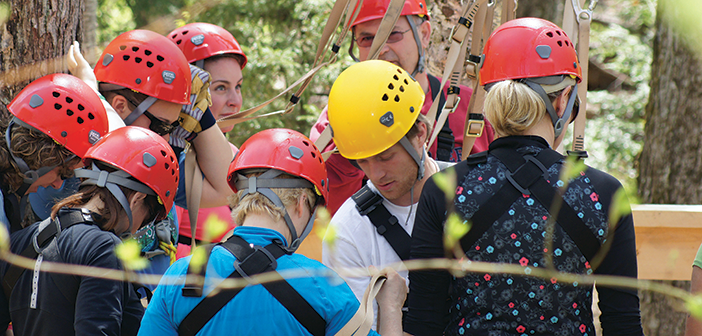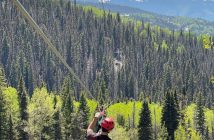Pingle recommends guides also use the practice area or first zip line as an opportunity to gauge what guests can do and if they will need help. “Ground school is a chance to really judge your guests,” she says. “Are people listening? Can they do the skill? Get them to demonstrate the skill and find out who will need coaching. Are they scared? Get an idea of how they are going to do.”
An area that the zip line industry has worked on improving over the years is steering—in particular, making sure that guests are facing in the direction they are traveling. “On a handbrake tour, you always want to put your hand behind the trolley as you try to slow yourself down,” Pingle says. “If you’re spinning, you don’t know which way is forward or backward, and you could grab the cable or hit your arm on the cable.
“The industry was seeing a lot of burns on people’s arms, so that was a learning curve for the industry, and has caused a lot of tours to use to handlebars to help with steering,” she adds. Steering is less of a problem on shorter lines, but can be an issue on longer lines where wind might cause the guests to move around a bit.
GUIDE DELIVERY
Briefings and instructions shouldn’t sound memorized, and not just because they seem canned. As a participant at a zip line course, Pingle once saw a guide lose his place in his script when a guest asked a question. “He was completely derailed by the question and had to go back and repeat his last sentence to know where he was in the script.” That does not breed confidence.
“Instead of memorizing a script, we recommend memorizing bullet points and then ad libbing between those bullet points,” she says. The ad libbing might involve that patented guide humor, rhyme, or anecdotal story, but avoiding a canned delivery helps provide an engaging atmosphere that allows guests to feel comfortable asking questions about what they’ll encounter, as well as how to operate the safety systems.
Johnson agrees. “These young adults are outgoing and can express themselves. If you came to our parks, you’d see 10 different demo presentations by 10 different guides. They throw in their slant on it to keep everyone interested, focused, relaxed and having a good time.” That helps guests retain what they see and hear.
Pingle cautions that guides can get so wrapped up in how they are delivering the safety instructions that they forget to keep an eye on their audience and gauge their ability level. It may be necessary to remind some guides that presentation style is an important thing, but not the only thing.
KNOWING THE AUDIENCE
Whether it’s park design or safety, the challenges that parks encounter will often depend on the guests they cater to.
For example, the Pingles worked with a park that wanted to limit stairs on its course because they were located in an area that sees a number of larger tourists for whom stairs are difficult. “On the other hand, we had another client in Vail that had a bit of a lengthy hike on their course, and I asked them, ‘What do you do with people who are not in the best shape?’” Pingle recalls. “They all kind of looked at each other and said, ‘We really don’t get people who are out of shape.’ So a lot of what we do with clients depends on their clientele and where they are located.”
Another course preferred to give a handout to guests and have them read through some of the hazards, almost like a participant agreement.
Johnson says the demo course is a non-offensive way of determining who should be up in the trees and who shouldn’t be. “You get all shapes and sizes,” he says. “By having them go through the demo course, once they’ve done the demos, some people make the decision on their own that ‘perhaps this isn’t for me.’ We don’t want to put people on a scale or tell them they are too heavy, but maybe they say, ‘I will let my kids do this.’”
It’s also important to talk with guests about any course-specific issues or concerns. Since the outline of the Pingles’ ground school sessions has stayed relatively consistent through the years, much of their focus has been on making training sessions very site-specific. “We worked with a tour briefly in Canada, and they had to mention bears,” she says. “We don’t have many courses where bears are an issue.
“Everything we do is always evolving, but it evolves with the needs of that course.”
Longtime staff trainer Lori Pingle of Get A Grip Adventures offers a few helpful rules to live by when it comes to training your guests.
1. Don’t overwhelm your guests.
Make sure your presentation is broken up in easy-to-understand sections.2. Keep the jargon to a minimum.
Many guests have never been near an aerial park or zip line and don’t understand insider terminology. Explain each term you use, and make sure guests understand what it refers to.3. Know your park.
Determine what the key components are for your specific system and what that means to the guest experience.4. Start with the big picture.
Tell guests what you’ll be explaining, what they’ll be expected to do, and what the course will have as they go through it. Cover the specifics from there—if it’s a handbrake tour, for example, explain that they will all be demonstrating the skills and be tested.






